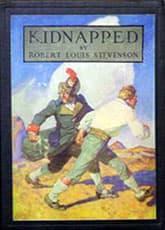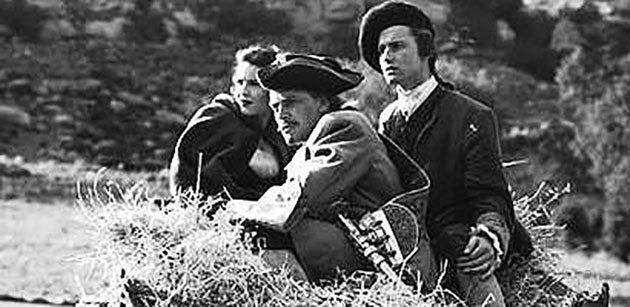Kidnapped
Critique • Quotes • At the movies
 1913 edition
1913 editionFirst publication
1886 in Young Folks magazine
First book publication
1886, England
Literature form
Novel
Genres
Literary, historical fiction, adventure, youth
Writing language
English
Author's country
England
Length
Approx. 88,000 words

Sue England, Dan O'Herlihy, Roddy McDowall find love and adventure in 1948'sKidnapped.
Adventures in low morals and Highland politics
Kidnapped (1948): Also known as Robert Louis Stevenson's Kidnapped; film, 81 minutes; director William Beaudine; writer Scott Darling; featuring Roddy McDowall, Dan O'Herlihy, Sue England, Roland Winters
As a great adventure story—a proto-thriller, one might say—Robert Louis Stevenson's Kidnapped is a natural for movie adaptation. And in fact both Hollywood and international productions have taken cracks at it—for both large and small screen.
But Stevenson's tale is more complex than may be expected. Few adaptations manage to capture the subtleties of Scottish politics and of British morality that are seamlessly woven into the novel.
Too sweet by half
It's officially called Robert Louis Stevenson's Kidnapped, but the 1948 Hollywood-made Kidnapped is far from the author's vision.
First, give aging child star Roddy McDowall a little credit. As an associate producer, the 20-year-old must have had some power in pulling together a rendition of the Stevenson classic. He's at the top end of the suitable age range for David Balfour and his accent is closer to British than Lowland Scottish, but his trademark sincerity comes close to making this production work.
But there is too much against him. The film is produced by Monogram Pictures, known as a low-budget action studio, specializing in westerns. And the cheapness shows. We never really get a sense we're in Scotland—and we're not. Outdoor scenes were shot on California's Catalina Island. The Highlands never looked more barren than in this movie's shades of grey.
Long shots of the ship onto which David is shanghaied are said to be of James Cagney's three-mast schooner, but the shipboard scenes are obviously shot in the studio, as are other indoor sets.
Irish actor Dan O'Herlihy, in one of his early heroic roles (see also in the later Robinson Crusoe), is well cast also as the Scottish rebel Alan Breck. But the film gives him little scope. His swashbuckling, reckless ways are reduced to a couple of sword fights and his mercurial, enigmatic character has all the rough edges knocked off. He functions in the film as little more than a father figure for David and Aileen.
Ah, yes Aileen. A love interest for David. Sue England is appropriately spunky and coquettish for the Highland lassie role as written—but do we really need a love story grafted onto Kidnapped? Pure Hollywood, but in this case it warps the second half of the tale. It is not helped much by the saccharine score either.
The exciting flight across Scotland with British soldiers at their heels, and with Scottish clan rivalries bounding them back and forth, is limited to barely ten minutes of screen time, making it a surprise to us when David tells the friendly lawyer near the end he's been on the run for two months.
Another major change to the Kidnapped story is the return of the supposedly drowned sea captain, not once but twice—in order to have both villains of the piece meet their deserved ends together.
The staging is also rather dull too, with actors usually standing around talking to each other. Director William Beaudine, who came up through silent films, seems to have lived up to his nickname of "One-Shot" by filming every scene as haphazardly as possible.
A strangely lifeless adventure film by an action-oriented studio.
— Eric

